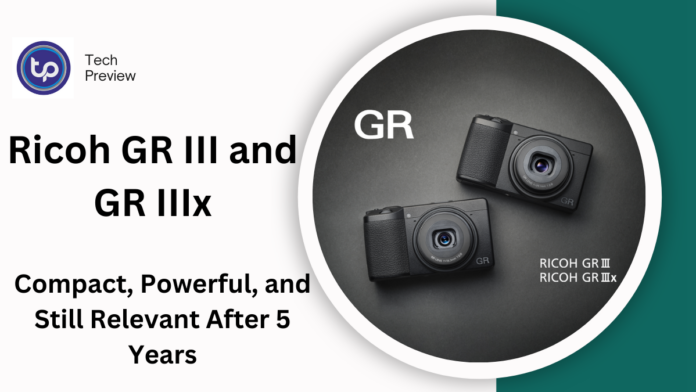It’s been five years since the Ricoh GR III made its debut, and it remains a standout choice for compact camera enthusiasts.
Not only does it continue to hold up against newer models, but the GR III and its updated sibling, the GR IIIx, are still among the best options available for photographers seeking high performance in a compact body.
But how do these cameras compare to other offerings in the market, and is it worth investing in one today? Let’s dive in.
Compact Powerhouse: Ricoh GR III Overview
The Ricoh GR III is a pocket-sized marvel, with a reputation for delivering excellent image quality without the bulk of traditional DSLR cameras.
If you’re someone who values portability but refuses to compromise on performance, the GR III is a go-to choice.
MUST READ: PS5 vs. PS5 Slim vs. PS5 Pro: What’s the Real Difference?
Key Features of the Ricoh GR III:
- Sensor: 24.2MP APS-C sensor
- Lens: 18.3mm (28mm equivalent) f/2.8
- Screen: 3.0-inch LCD touchscreen
- Autofocus: Hybrid AF system (Phase detection + Contrast detection)
- Battery Life: Approx. 200 shots per charge (CIPA rating)
- Size: 4.4 x 2.5 x 1.4 inches (compact and pocketable)
- Weight: 257g (lightweight)
The GR III is known for its sharp, vibrant images and the ability to shoot in a variety of lighting conditions thanks to the fast f/2.8 lens.
Whether you’re capturing street scenes, landscapes, or portraits, the GR III produces stunning detail, with its large APS-C sensor capturing more light than typical point-and-shoot cameras.
Design and Build Quality
Despite being compact, the GR III feels solid in your hand, with a minimalistic yet functional design. The camera body is made of magnesium alloy, offering durability, and its rubberized grip ensures a comfortable hold.
There’s no over-the-top flair in terms of aesthetics, but the camera’s clean lines and simple controls add to its appeal for those who prefer function over form.
- Button layout: The GR III keeps things simple. With minimal buttons and a clear, intuitive interface, it’s easy to adjust settings on the fly.
- Display: The 3-inch touchscreen is bright and responsive, but note that it’s fixed—not articulated. Still, for street and travel photographers, this isn’t much of a drawback.
Ricoh GR IIIx: The New Sibling
Ricoh released the GR IIIx as an updated version of the GR III. While they share many similarities, the GR IIIx brings a couple of key differences that will appeal to specific types of photographers.
Key Features of the Ricoh GR IIIx:
- Sensor: 24.2MP APS-C sensor (same as the GR III)
- Lens: 26.1mm (40mm equivalent) f/2.8
- Screen: 3.0-inch LCD touchscreen
- Autofocus: Hybrid AF system (similar to GR III)
- Battery Life: Approx. 200 shots per charge (CIPA rating)
- Size: 4.4 x 2.5 x 1.4 inches
- Weight: 261g
Key Differences:
- Lens Upgrade: The biggest difference between the GR III and GR IIIx is the lens. While the GR III offers a 28mm equivalent lens, the GR IIIx comes with a 40mm equivalent lens. This makes the GR IIIx better suited for portraiture, street photography, and scenarios where you need a slightly tighter field of view. Some users may prefer the 40mm for a more natural perspective when shooting portraits or subjects at a distance.
- Size and Handling: The GR IIIx is marginally heavier than the GR III, but the difference is negligible. The handling and layout remain almost identical, making the switch between the two models seamless for users who already own the GR III.
Performance: Image Quality and Autofocus
Both the GR III and GR IIIx perform excellently in terms of image quality. Equipped with a 24.2MP APS-C sensor, they deliver sharp, vibrant images, with excellent detail even in low light. Both cameras also benefit from in-body image stabilization (IBIS), which is incredibly useful when shooting handheld in dimly lit environments or capturing fast-moving subjects.
Low-Light Performance
The GR III and GR IIIx shine in low-light conditions. Thanks to the large APS-C sensor and fast f/2.8 lens, both models can capture images with minimal noise in dim settings.
While not as capable as full-frame sensors, these cameras still outperform many compact and smartphone options when it comes to low-light capabilities.
Autofocus
Both cameras feature a hybrid autofocus system, which combines phase detection and contrast detection. While it’s not as fast or as sophisticated as high-end mirrorless models, it works well for street and casual photography. In good light, focusing is quick and accurate, but in low-light or tricky scenarios, there might be some hesitation.
- Face Detection: For portrait shooters, the face detection feature is a nice touch, ensuring sharp focus on subjects’ faces even in crowded scenes.
- Continuous Focus: Both models perform adequately for continuous autofocus, but you might experience some hunting in challenging conditions.
Video Capabilities
While Ricoh’s GR cameras are primarily designed for still photography, they still offer some video capabilities.
The GR III and GR IIIx can shoot 1080p video at up to 60fps, which is great for basic vlogging or capturing candid moments.
However, don’t expect professional-grade video quality or 4K resolution here. The camera’s design focuses more on photography than videography, so if video is your priority, other options may be a better fit.
Battery Life and Usability
Battery life on both cameras is relatively modest, offering about 200 shots per charge. This isn’t a dealbreaker for most casual shooters, but it’s something to keep in mind for longer shooting sessions.
Fortunately, both models feature USB charging, so you can easily charge on the go using a portable power bank.
Another important factor for usability is the camera’s handling in the real world. Both models are known for their exceptional ergonomics despite their small size.
The controls are intuitive, and the small body makes them incredibly portable—perfect for street photographers who need to carry the camera discreetly for hours on end.
Which One Should You Choose: GR III or GR IIIx?
The GR III and GR IIIx are both excellent choices, but your ideal model will depend on your specific needs.
- Go for the GR III if you prefer a wider 28mm equivalent lens for street photography, landscapes, and environmental portraits.
- Go for the GR IIIx if you prefer a more natural focal length of 40mm equivalent, making it better for traditional portraits and everyday scenes.
In either case, both cameras offer superb image quality, portability, and ease of use.
Pros and Cons:
| Feature | Ricoh GR III | Ricoh GR IIIx |
| Sensor | 24.2MP APS-C | 24.2MP APS-C |
| Lens | 18.3mm f/2.8 (28mm equivalent) | 26.1mm f/2.8 (40mm equivalent) |
| Autofocus | Hybrid AF system | Hybrid AF system |
| Battery Life | 200 shots per charge | 200 shots per charge |
| Weight | 257g | 261g |
| Best for | Street photography, landscapes | Portraits, everyday scenes |
| Video | 1080p at 60fps | 1080p at 60fps |
Conclusion
Despite being five years old, the Ricoh GR III (and the newer GR IIIx) remain among the best compact cameras available today. Whether you choose the GR III for its wide-angle lens or the GR IIIx for its more versatile 40mm focal length, both cameras provide impressive image quality, portability, and ease of use.
If you’re looking for a small, discreet camera that delivers high-quality images, the Ricoh GR III and GR IIIx are hard to beat. They may not be the latest on the market, but they’ve aged remarkably well and continue to stand the test of time.
People May Ask
Q: Is the Ricoh GR III good for beginners?
While it’s not as beginner-friendly as some other options, the GR III’s simple interface and excellent image quality make it a great choice for someone looking to step up from a smartphone or entry-level camera.
Q: Can I use the GR III or GR IIIx for video?
Both models can shoot 1080p video at up to 60fps, but they’re not designed with videography in mind. They’re best for stills, with video as a secondary feature.
Q: What are the differences between the GR III and GR IIIx?
The key difference is the lens. The GR III has a 28mm equivalent lens, while the GR IIIx has a 40mm equivalent lens. The GR IIIx is better for portraits and slightly more versatile for everyday use.
Click here to learn more.








